More languages
More actions
| Asia | |
|---|---|
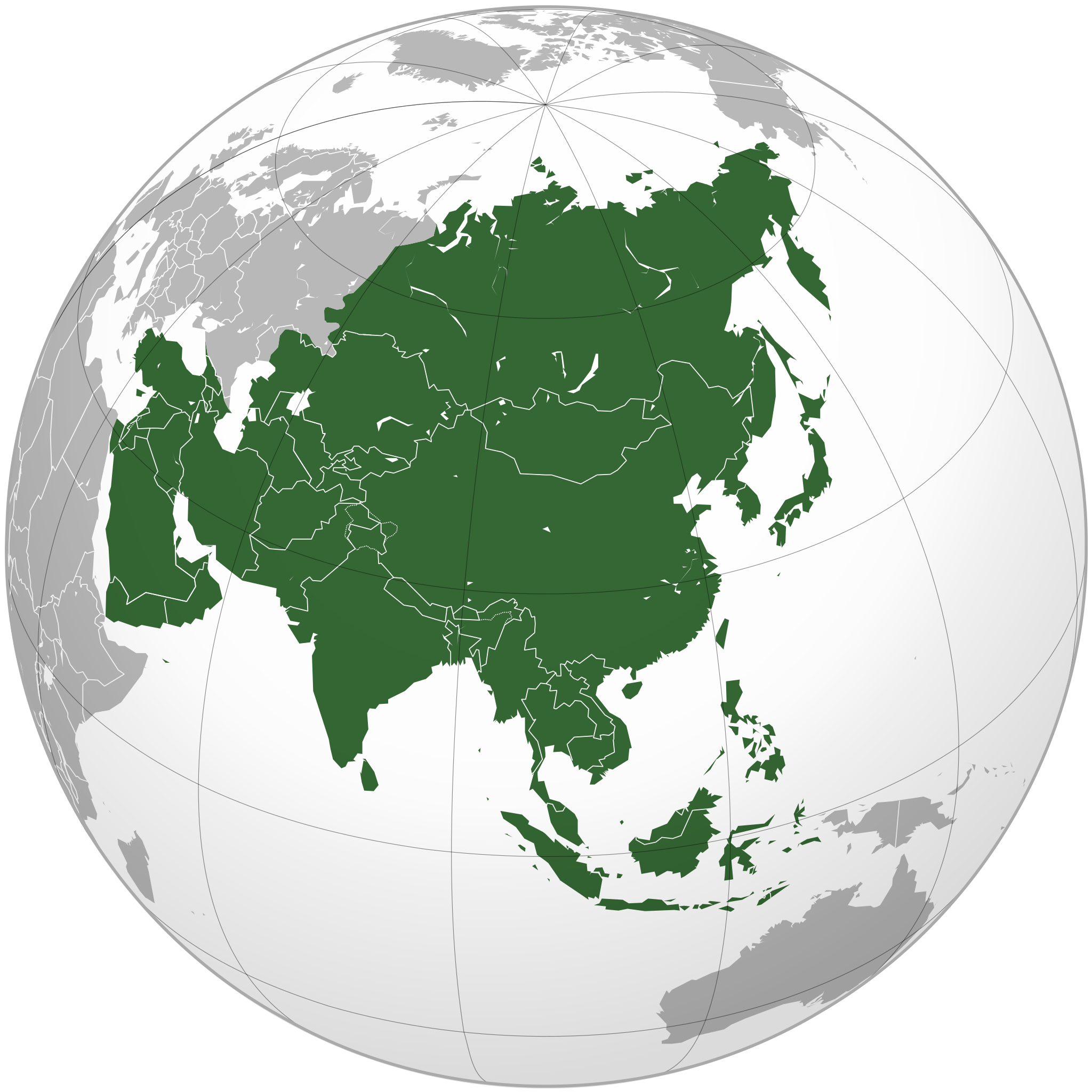 | |
| Area | |
• Total | 44,579,000 km² |
| Population | |
• 2018 estimate | 4,560,667,108 |
Asia is the largest and most populated continent in the world.[1] The population of Asia makes up about 60% of the world population.[2][3] It shares the continental landmass of Eurasia with the continent of Europe, and the continental landmass of Afro-Eurasia with Africa and Europe. In general terms, Asia is bounded on the east by the Pacific Ocean, on the south by the Indian Ocean, and on the north by the Arctic Ocean. The border of Asia with Europe is a historical and cultural construct, as there is no clear physical and geographical separation between them, although certain rivers and mountain ranges are commonly considered as forming a rough conceptual border.
The PRC, DPRK, Vietnam, and Laos are all located in Asia. Russia is commonly considered to span both Europe and Asia, with most of Russia's territory being located in the Asian continent, while most of the country’s population resides in the European side.[4] Kazakhstan also has contiguous territory in both Europe and Asia. The Ural River, which flows into northwestern Kazakhstan, is considered to be part of the border between Europe and Asia.[5] Turkey is also commonly considered to be located in both Europe and Asia.[5][6] Egypt is a country whose territory is located mostly in North Africa. A part of Egyptian territory, known as the Sinai Peninsula, is considered to be part of Asia and serves as a land bridge between Africa and Asia.[5]
Asia varies greatly across and within its regions with regard to ethnic groups, cultures, environments, economics, historical ties and government systems. It also has a mix of many different climates including desert, subtropical, temperate, subarctic, and polar areas.
Regions
Asia is often divided into several subregions, although there is no universal consensus on these divisions, and many have overlapping or flexible demarcations.
Some commonly described regions of Asia include Central Asia, East Asia, South Asia, Southeast Asia, West Asia (also commonly called the Middle East), and North Asia (also commonly called Siberia).
Western imperialism in Asia
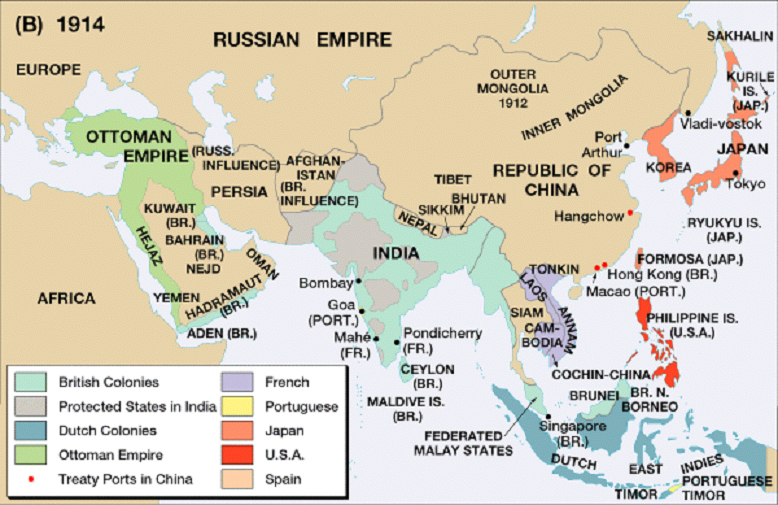
European-style colonial empires and imperialism and their effects have operated in Asia for centuries, and much of Asia's modern history is entangled with its relationship to Western colonialism. Western colonialism in Asia originated in the 15th-century search for trade routes to the Indian subcontinent and Southeast Asia that led to a period of extensive overseas exploration by Europeans, with the Portuguese and the Spanish at the forefront, later joined by the Dutch, the English and the French. The era saw the widespread enslavement, exploitation and military subjugation of native populations and the extraction of their natural resources, concurrent with the growing economic influence and spread of European culture and technology. Several different Western European powers eventually established colonies in Asia, and by the end of the nineteenth century, much of the region was under European colonial rule.[7]
Noteworthy entities in the European colonization of Asia were the British East India Company, a powerful international corporation backed by a military force,[8] and its competitor, the similarly powerful Dutch East India Company, which began to exert control over their regions of operation and take on governmental functions. At its peak, the small group of merchants of the British East India Company ruled over two hundred million people, and it can be said to have created the infrastructure the British would use after they formally colonized the region in the mid-nineteenth century.[7]
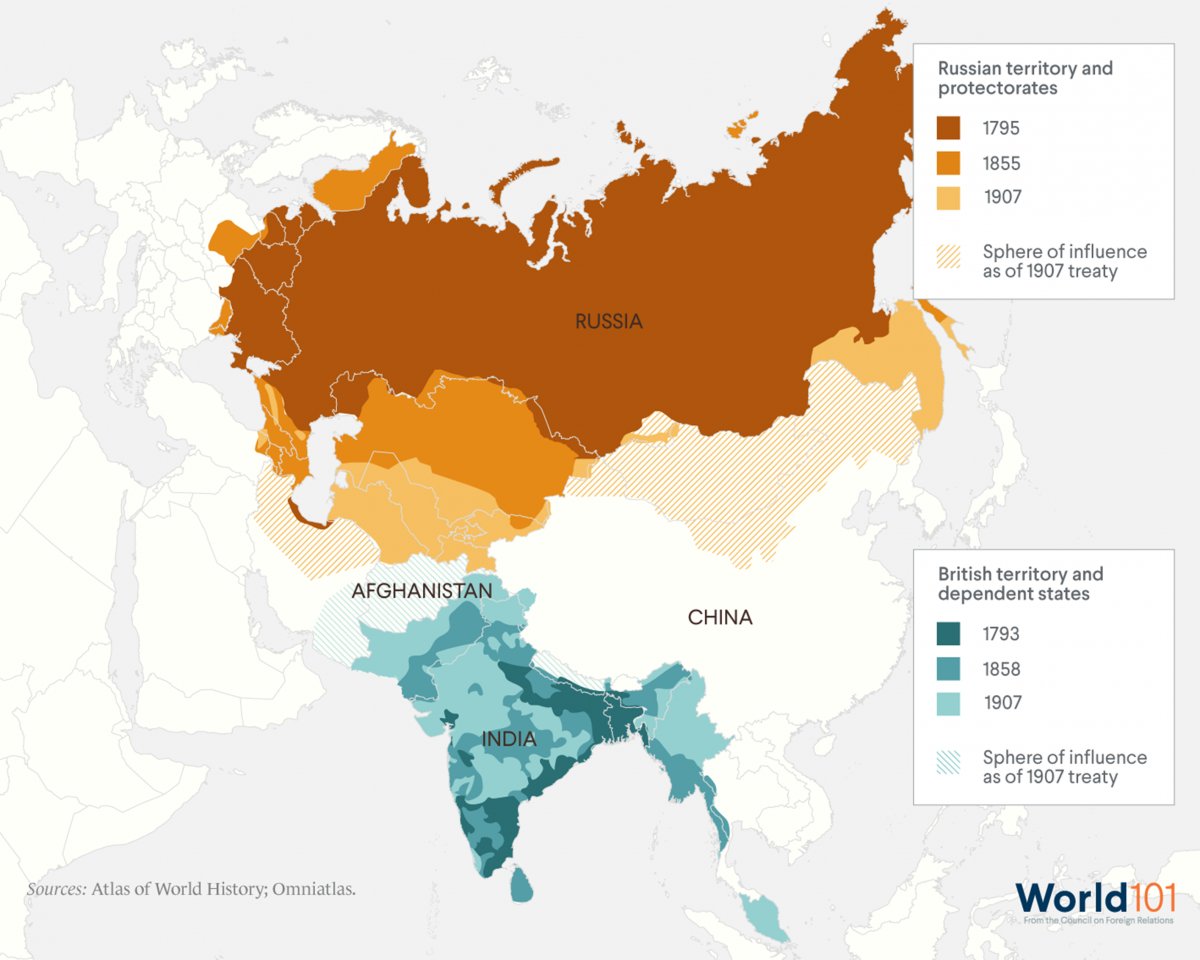
Central Asia saw power competition between Great Britain and Russian Empire during the 19th century. This was a period of Russian expansion and the moves made by Britain to counter what they perceived as Russian aggression in the region, which they believed would threaten their colonial influence in India. This period includes the First Anglo-Afghan War.[9]
The French colonies of the region, commonly called French Indochina, comprised Cambodia, Laos (from 1899), the Chinese territory of Guangzhouwan (from 1898 until 1945), and the Vietnamese regions of Tonkin in the north, Annam in the centre, and Cochinchina in the south. The capital for most of its history (1902–45) was Hanoi; Saigon was the capital from 1887 to 1902 and again from 1945 to 1954. As France attempted to maintain its grip on these countries, the Anti-French Resistance War, also known as the First Indochina War, broke out. The conflict gradually escalated into the Vietnam War, also known as the Resistance War Against the United States or the Second Indochina War.
The United States also maintains a military presence in South Korea, as well as retaining legal control of the South Korean military during wartime. According to the South Korean People's Democracy Party, South Korea "is a complete colony occupied by the U.S. military, is politically oppressed by the U.S., and is economically subordinate to imperialist countries, including the U.S. After the military coup of 1961, the rule of fascist military dictatorship continued for 30 years, and since then a pro-US neo-liberal regime has operated in the country. It is severely exploiting the workers, farmers, and all the people."[10] The U.S. refusal to give up its influence in South Korea contributed to the outbreak of the Korean War.
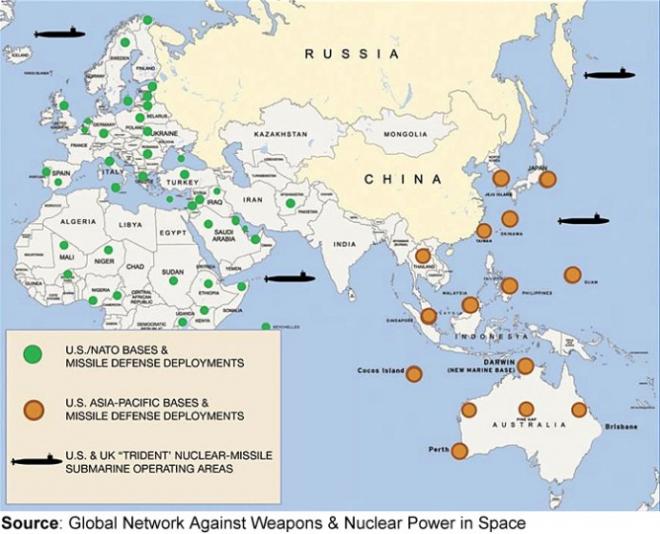
Japan, which itself was an imperial power, was not formally colonized by Western powers, but it has experienced semi-colonial situations, and modern Japan has been influenced by Western colonialism. Competition between the United States and Japan fueled the colonization and militarization of the Pacific region by both powers. During the Pacific War, Japanese propaganda painted the Japanese empire as a moral force fighting against the evil empires of the West, and liberating Asia from Western colonialism. The U.S.-led occupation after the Pacific War marked the first formal foreign rule of the nation.[11] In the present day, the U.S. maintains a military presence in Japan, which some Japanese citizens oppose and protest through the anti-base movement. Okinawa, which was initially colonized by Japan in the 1800s, remained under US administration until 1972, and throughout this period, the United States built additional military bases in the prefecture. Since 1972, Japan has administered Okinawa and has allowed US bases to remain there, in accordance with the 1960 US-Japan Security Treaty, which permits US bases in Japan.[12]
According to Nikkei Asia in 2021, Asia now accounts for half of US overseas troop deployments, and the U.S. has been deploying more troops in the East Asian and Pacific regions than in Europe and the Middle East over the past two decades.[13] According to a 2021 Al Jazeera article, "nearly half of all US military deployed abroad, some 80,100 American personnel, are stationed in Japan with 53,700 and South Korea with 26,400." The largest US military installation in the Middle East is the Al Udeid Air Base, located west of Doha, Qatar, which hosts around 11,000 American and coalition service members. Covering an area of 24 hectares (60 acres), the base accommodates almost 100 aircraft as well as drones.[14]
Japanese imperialism

In the nineteenth century, Western powers saddled non-Western states with a variety of unequal arrangements, from fixed tariffs and extraterritoriality to formal colonization. In the case of Japan, a treaty was signed between Japan and the U.S., which Japanese nationalists protested as being disadvantageous to Japan. Leading their list of goals was the need to strengthen the military in order to withstand future Western impositions. They studied the organizations and techniques of Western governments and militaries, and they modeled their own institutions on them. Thus the Meiji government was born in an imperialistic milieu, and their primary models were the world's leading imperialistic states.[15] According to Encyclopedia Britannica, "Achieving equality with the West was one of the primary goals of the Meiji leaders."[16] According to Peter J. Seybolt of the Center for Asian Studies at the University of Vermont, "In the 19th century, Britain, the United States and France, soon followed by Russia, Germany and other Western nations, forcefully 'opened' a reluctant East Asia to Western trade and religious proselytizing by imposing a series of 'unequal treaties'" and, after a period of internal turmoil, "the Japanese united as a nation determined to learn from the West techniques for 'strengthening the army and enriching the country.'"[17] According to Seybolt:
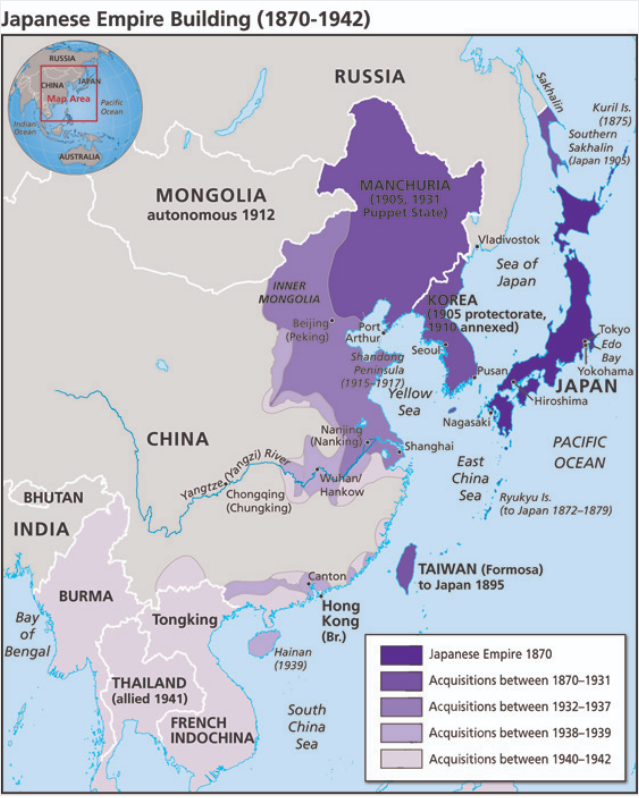
Within a remarkably short time the Japanese had acquired the power to compete with the West on its own terms, whereupon they took the initiative to "open" Korea, the most conservative of the three East Asian nations, and join Western nations in imposing unequal treaties on it. In 1894-95 Japan defeated China in a war to determine control of Korea, and a decade later it decisively defeated Russia in a war over exploitation rights in Korea and Manchuria in northeastern China. [...] Chinese historians estimate that more than 20 million of their compatriots died as a direct result of the war, and uncounted millions of others were injured. In the most notorious single incident of the war an estimated 150,000 to 350,000 Chinese men, women, and children were slaughtered in a frenzy of indiscriminate killing by Japanese troops when they entered Nanjing, then the capital of the Republic of China. The infamous Nanjing massacre was a calculated attempt by local Japanese commanders to terrorize the Chinese into capitulating. The effect was the opposite. Chinese resistance stiffened, and memories of the atrocity are still fresh.[17]
Early in the Meiji period, the Japanese government consolidated its hold on the peripheral islands of the Japanese archipelago. In the territory inhabited by the Ainu, the Meiji regime tried to wipe out markers of Ainu ethnicity (earrings and tattoos, for example) and prohibited the Ainu from practicing their religion or hunting in their ancestral hunting-grounds. In 1899, the state enacted the "Law for the Protection of Former Hokkaidō Aborigines," which removed land from communal control, thereby forcing the Ainu to become petty farmers. Japanese assimilation policies not only dispossessed the Ainu, they destroyed nearly all indicators of Ainu cultural and ethnic identity. The Japanese government also embarked on a policy of cultural assimilation in Okinawa, paying particular attention to discouraging the use of the native Okinawan language and enforcing the use of standard Japanese among schoolchildren. Eventually, leading Japanese intellectuals and government officials in the 1880s and 1890s began to support the idea of winning control over neighboring regions. Three factors were responsible for this drive: a nationalist desire for equality, desire for access to the raw materials and markets of East Asia (which could be lost if a Western power gained control of the regions first), and other strategic goals, and Japan eventually aimed to bring China and Korea under its control.[15] Between 1910 and 1945, Japan worked to wipe out Korean culture, language and history and took control over Korea's labor power and land.[18] At the height of its power in 1942, the Japanese Empire controlled Korea, Manchuria, and parts of China and Indonesia.[19] The memories of Japan's imperialism, exemplified by events such as the Nanjing massacre, the sexual exploitation of comfort women in various countries, criminal medical experimentation, slave labor, and other such atrocities still affect Japan's relations with other Asian countries in the present day.[17]
References
- ↑ "Population of Asia". Populationof.net. Archived from the original on 2021-10-29. Retrieved 2022-01-16.
- ↑ “Global Population: Distribution by Continent 2021 | Statista.” Statista. 2021. Archived 2022-08-14.
- ↑ “Population of Asia (2022) - Worldometer.” 2022. Worldometers.info.
- ↑ Shvili, Jason. 2021. “Is Russia in Europe or Asia?” WorldAtlas. March 26, 2021.
- ↑ 5.0 5.1 5.2 Shvili, Jason. 2021. "Transcontinental Countries of the World.” WorldAtlas. May 7, 2021.
- ↑ Sally Polly. “Is Turkey in Europe or Asia?” KnowInsiders. September 20, 2021.
- ↑ 7.0 7.1 “South and Central Asia | Modern History.” 2022. World101 from the Council on Foreign Relations.
- ↑ Dalrymple, William. 2015. “The East India Company: The Original Corporate Raiders.” The Guardian. March 4, 2015. Archived 2022-08-14.
- ↑ Alexander Cooley. “Central Asia: A Political History from the 19th Century to Present.” Asia Society. Archived 2022-08-14.
- ↑ People's Democracy Party and Liberation School. “70 Years Too Long: The Struggle to End the Korean War – Liberation School.” Liberation School – Revolutionary Marxism for a New Generation of Fighters, 25 June 2020. Archived.
- ↑ "Japan, Colonized." Encyclopedia of Western colonialism since 1450. Encyclopedia.com.
- ↑ Olivia Tasevski (17 Feb 2022). "Okinawa’s vocal anti-US military base movement" The Interpreter.
- ↑ JUNNOSUKE KOBARA and YUKIO TAJIMA (MAY 25, 2021). "Military might and flashpoints shift from West to East" Nikkei Asia.
- ↑ Mohammed Hussein and Mohammed Haddad (10 Sep 2021). "Infographic: US military presence around the world" Al Jazeera. Archived from the original on 2022-08-14.
- ↑ 15.0 15.1 Andrew Reed Hall. “Japanese Imperialism and Colonialism | Japan Module.” University of Pittsburgh.
- ↑ "Japan: The emergence of imperial Japan". Encyclopedia Britannica. Archived from the original.
- ↑ 17.0 17.1 17.2 Peter J. Seybolt. "China, Korea and Japan: Forgiveness and Mourning" Asia Society. Archived from the original on 2022-08-14.
- ↑ Erin Blakemore (July 28, 2020.). "How Japan Took Control of Korea" History.com.
- ↑ “Fragments of Empire: Effects of Japanese Imperialism in Korea, China, Japan, and Vietnam – Marlboro College Archives.” Emerson.edu.
